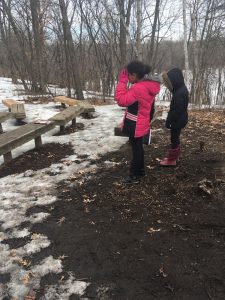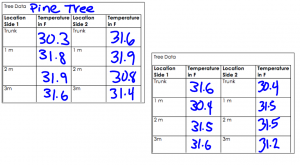Remembering to Change
I was doing so well at writing these posts to help me reflect and document this year, then suddenly it’s April and three weeks have passed. Ok, well only two weeks of school since spring break was in there. And even though it’s April, I am sitting in bed with the cats at my feet nearing the end of my fourth snow day of the year -a new record for me. So it felt like the perfect time to do some catching up.
This school year I had committed to having a focus on outdoor learning. Part of this decision came from an internal desire to see our school yard used better, part of it came from the Teachers Guild Fellowship I was awarded last summer and part came from my need to shake up curriculum a bit (get out of a rut). Focusing on finding ways to use out outdoor spaces sometimes has taken work and many times meant trying new ideas for the first time.
In the midst of winter, it is also easy to slip back into old ways and do lessons that were known and comfortable. But the nice thing about making your goals public – for me that meant sharing my intention at an all staff meeting at the beginning of the year- is that your colleagues end up holding you accountable; sometimes in unexpected and unintended ways. It was a actually a conversation with our art teacher, about some topic I don’t even remember the details of now, where she casually mentioned me going outside. It literally made me do a double take – That’s right, I should be going outside.
So I found a way to make it happen. I had been working with the second grade team on a mitten experiment, but one teacher was also ready to try something else. We started by heading outside to record the temperature of different surfaces in our outdoor classroom: wood benches, snow, dirt, rocks, blacktop. We also did each surface twice, once in a shady spot and once in a sunny spot. On this particular day, it was fairly overcast so not easy to tell where the sunny or shady spots were. Back inside we shared data and found some unexpected results. The wooden benches were reading warmer than the asphalt. We brainstormed a number of possible explanations.


However, the conversation also got more interesting when students also shared other observations they had from outside, including how the snow is more gone around the trees than in open spots. This led students to hypothesize that trees might give off heat just like humans give off body heat. It’s conversations like this that make me love my job. My response was: Let’s find out!
We decided we should test the soil temperature this time rather than surface (so the temperature probe would be placed in the ground rather than resting flat on top). We also decided that to prove if we were right we’d need to take the temperature not just by the tree but moving out from the trunk as well. We also decided to collect data from two sides of the trunk and move out a meter each time. If our idea was right, we’d see the warmest temperatures near the trunk and it would get colder as we got further away.

The next day we bundled up, headed out and found two trees to use – one pine and one ash so we could also see if leaves made a difference. It was a little more challenging than anticipated and found several spots where the ground was frozen pretty solid, not letting us insert the temperature probe very far. It also happened to start sleeting on us while we were out, making it hard to focus and observe, but we got our data and headed in.
Our data was inconclusive, but it led to a great discussion about how to find patterns in data and how much change we would have needed to see to tell if there was a pattern. It also led to a great follow up discussion, that if trees don’t give off ‘body’ heat, how else can we explain why there is more snow gone around the trees.

This lesson served as a great reminder to me of a number of components of my job:
- It’s fun and challenging to be open to unexpected results. In fact, this whole lesson was not at all what I had planned. I had thought we’d use the temperature data the first day to do an ice cube melting investigation. But the students noticed something else and had genuine wonderings and I LOVE that I got to witness that and be a part of their discovery. I think in the end more true learning came from them testing out their own idea than would have come from me directing them.
- It takes time and energy to keep up with a goal. In some ways I had to be reminded that I was supposed to be changing things this year. I appreciate the flexibility of my schedule as well as my family as I spend a lot of time researching and thinking about how to make these changes.
- I’ve heard people reference making your goals public before, but this really hit home for me after this experience. If I had simply thought about doing more outdoor lessons and kept that to myself, this lesson might never have happened.
So, if you’ve actually read this far let me be the friendly reminder to you. What did you want to work on changing this year?